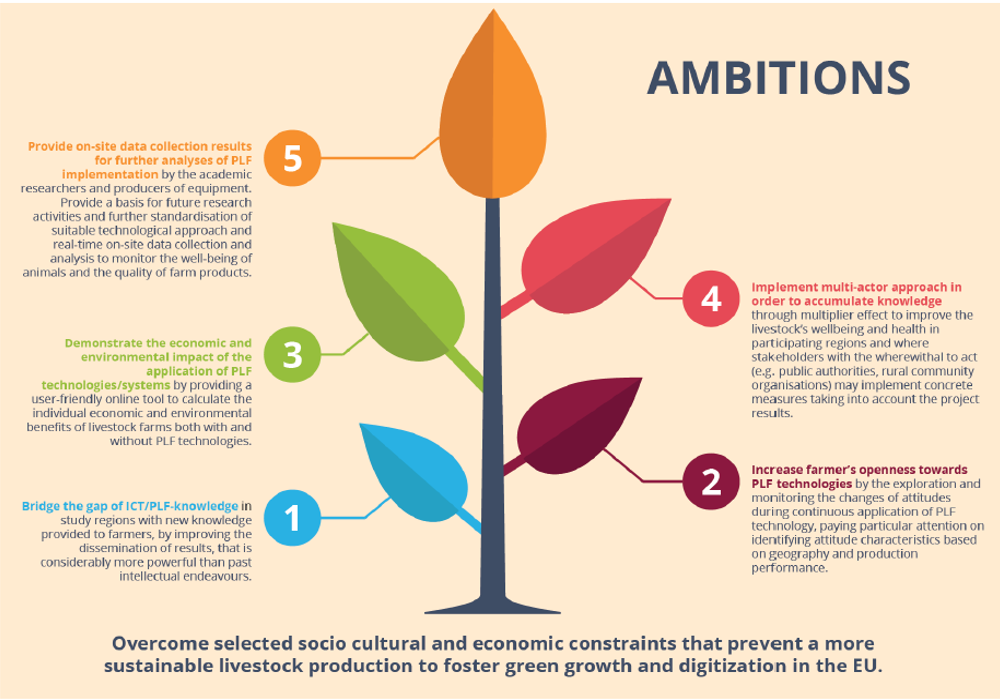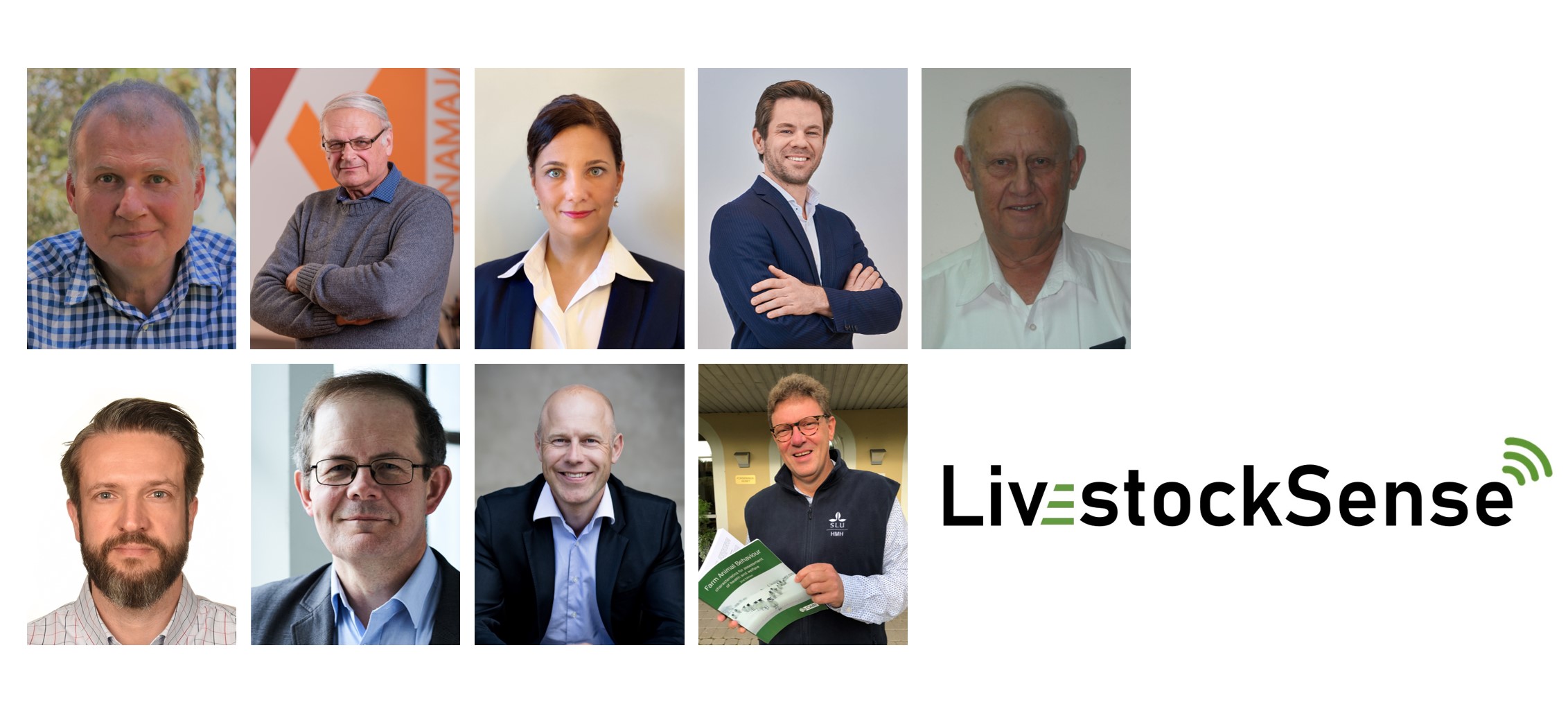
Introduction
The main objectives of the LivestockSense are
- To improve the economic and environmental viability of livestock farms through application of advanced information and communication technologies AND
- To identify/remove social barriers for technology adoption to achieve a wider use of ICT on farms.
This will be achieved by selecting and supplying a number of farms in 5 key geographical areas in Europe with Precision Livestock Farming (PLF) tools. Both qualitative and quantitative surveys will be used to understand farmers’ attitudes towards PLF tools to identify barriers for the limited adoption of ICT based technologies. LivestockSense will also involve other actors in the value chain, such as technology developers and policy makers to explore attitudes towards the PLF and understand the future expectations of the livestock sectors. Recommendations will be made to remove or reduce the impact of those barriers. The likely economic and environmental benefits associated with technology adoption will also be incorporated in a learning database and associated website using AI based technologies and ICT tools for decision support.
Background
Utilisation of ICT based tools in agriculture is crucial for the EU to become internationally competitive, socially inclusive and climate neutral by 2050, the goal set in the European Green Deal. However, promoting and adoption of ICT tools is a major challenge in animal production. Although advanced ICT solutions improve the environmental and economic viability of animal husbandry; farmers are not open to new technologies due to a lack of in-depth knowledge about the implications of its usage. The development of sustainable animal husbandry requires the removal of socio-economic and cultural barriers preventing the wider adoption of ICT tools.
Main project activities
In summary, the LivestockSense will be implemented to
- Understand the reasons for the limited use of ICT tools,
- Explore farmers 'attitudes towards PLF systems,
- Document farmers' information needs,
- Assess their knowledge of decision-making processes about the information provided by ICT tools, and support farmers in adapting to the PLF through workshop, mentoring and a web-based application with an open Application Programming Interface (API).

Expected social impact
Increase environmental and social responsibility among farmers.The main motivation for using PLF tools and the key barriers preventing their adoption will be identified by the project. The consultations following the installation of PLF tools will provide farmers with a continuous learning opportunity and strengthen the social and environmental responsibility as livestock farmers.
LivestockSense will provide a positive impact to the following UN Development Goals:
- Zero hunger (2)
- Good Health and Well-being (3)
- Responsible Consumption and Production (12)
- Climate Action (13)
- Life on Land (15)
Implementation and plans to reach target groups
Project results will be disseminated through a set of activities outlined in a strategic dissemination plan (WP5). The plan focuses on: (1) demonstrating how the results are relevant to agribusiness and thus enhance their investments in new digital technologies, improve competitiveness and reduce environmental footprint, (2) promoting a general awareness of the essential value of further digitalization and novel technologies in livestock production, and (3) clarifying the importance of European policy-making to facilitate digitalization in livestock production. Dissemination is planed through coordinated publications, on-line information via project portal, scientific conferences and other venues. Scientific publications will be aimed at high impact journals (including joint public-private publications) that will play a big role in the dissemination of the results.
Consortium

Coordinated by:
- Thomas Banhazi - AgHiTech Kft., Hungary
Partners:
- Eugen Kokin - Estonian University of Life Science, Estonia
- Thomas Neubauer - SBA Research, Austria
- Ildiko Edit Tikasz - NARIC Research Institute of Agricultural Economics, Hungary
- Uri Marchaim - MIGAL Galilee Research Institute, Israel
- Sebastian Opaliński - Wroclaw University of Environmental and Life Sciences, Poland
- Claus Aage Grøn Sørensen - Aarhus University, Department of Engineering, Denmark
- Thomas Bjerre - Innvite ApS, Denmark
- Stefan Gunnarsson - Swedish University of Agricultural Sciences, Sweden
Funded by:
- National Research, Development and Innovation Office, Hungary
- Ministry of Rural Affairs, Estonia
- Federal Ministry for Sustainability and Tourism, Austria
- National Technologiocal Innovation Authority, Israel
- National Centre for Research and Development, Poland
- Ministry of Environment and Food, Denmark
- The Swedish Research Council Formas, Sweden
News articles
Video
Introduction
The main objectives of the LivestockSense are
This will be achieved by selecting and supplying a number of farms in 5 key geographical areas in Europe with Precision Livestock Farming (PLF) tools. Both qualitative and quantitative surveys will be used to understand farmers’ attitudes towards PLF tools to identify barriers for the limited adoption of ICT based technologies. LivestockSense will also involve other actors in the value chain, such as technology developers and policy makers to explore attitudes towards the PLF and understand the future expectations of the livestock sectors. Recommendations will be made to remove or reduce the impact of those barriers. The likely economic and environmental benefits associated with technology adoption will also be incorporated in a learning database and associated website using AI based technologies and ICT tools for decision support.
Background
Utilisation of ICT based tools in agriculture is crucial for the EU to become internationally competitive, socially inclusive and climate neutral by 2050, the goal set in the European Green Deal. However, promoting and adoption of ICT tools is a major challenge in animal production. Although advanced ICT solutions improve the environmental and economic viability of animal husbandry; farmers are not open to new technologies due to a lack of in-depth knowledge about the implications of its usage. The development of sustainable animal husbandry requires the removal of socio-economic and cultural barriers preventing the wider adoption of ICT tools.
Main project activities
In summary, the LivestockSense will be implemented to
Expected social impact
Increase environmental and social responsibility among farmers.The main motivation for using PLF tools and the key barriers preventing their adoption will be identified by the project. The consultations following the installation of PLF tools will provide farmers with a continuous learning opportunity and strengthen the social and environmental responsibility as livestock farmers.
LivestockSense will provide a positive impact to the following UN Development Goals:
Implementation and plans to reach target groups
Project results will be disseminated through a set of activities outlined in a strategic dissemination plan (WP5). The plan focuses on: (1) demonstrating how the results are relevant to agribusiness and thus enhance their investments in new digital technologies, improve competitiveness and reduce environmental footprint, (2) promoting a general awareness of the essential value of further digitalization and novel technologies in livestock production, and (3) clarifying the importance of European policy-making to facilitate digitalization in livestock production. Dissemination is planed through coordinated publications, on-line information via project portal, scientific conferences and other venues. Scientific publications will be aimed at high impact journals (including joint public-private publications) that will play a big role in the dissemination of the results.
Consortium
Coordinated by:
Partners:
Funded by:
News articles
Better usage of Smart Technologies in agriculture to benefit farming, climate and animal welfare
Focus groups to shed light on adaptation of digital technologies in livestock production
Video